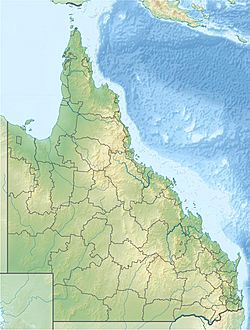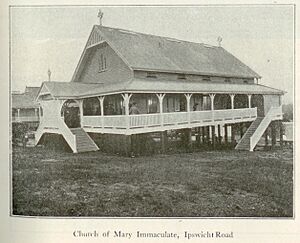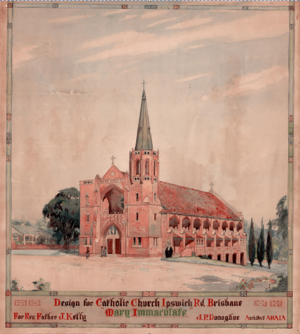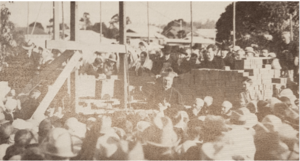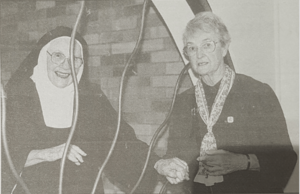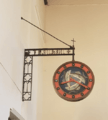Mary Immaculate Church, Annerley facts for kids
Quick facts for kids Mary Immaculate Church |
|
|---|---|
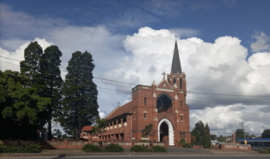
Mary Immaculate Church
|
|
| 27°31′01″S 153°01′50″E / 27.516928°S 153.030419°E | |
| Location | Annerley, Queensland |
| Country | Australia |
| Denomination | Catholic |
| Tradition | Latin Rite |
| Religious institute | Congregation of the Oratory of St. Philip Neri |
| History | |
| Status | Parish church |
| Founded | 11 October 1931 |
| Founder(s) | Archbishop James Duhig |
| Dedication | Mary Immaculate |
| Dedicated | 1 May 1932 by Archbishop James Duhig |
| Architecture | |
| Functional status | Active |
| Architect(s) | Jack Donoghue |
| Architectural type | Church |
| Style | Inter-war French Gothic |
| Years built | 1931–1939 |
| Construction cost | A£10,451 |
| Specifications | |
| Capacity | 600 people |
| Materials |
|
| Administration | |
| Parish | Annerley Ekibin |
| Archdiocese | Brisbane |
Mary Immaculate Church is a historic Roman Catholic church in the Brisbane suburb of Annerley, Queensland. It is listed on the Brisbane Heritage Register, which means it is an important local landmark. The church is cared for by the Brisbane Oratory, a community of Catholic priests.
Contents
History of the Church
The First Church and School
In the early 1900s, the suburb of Annerley was growing. Catholic families had to walk over five kilometres to get to church and school. A group of local people asked Archbishop James Duhig if they could build their own church and school.
The Archbishop agreed, and he bought land for the new building in 1912. The community worked together to build a timber building that could be used as both a church and a school. On June 14, 1914, Archbishop Duhig officially opened the new building. It was named Mary Immaculate Church.
The first priest, Fr James Gallagher, came from Rockhampton. The parish was very large, and priests had to travel on horseback. In 1920, the parishioners bought a ‘T’ model Ford car to help them get around.
Building the Current Church
Only ten years later, the parish had grown so much that a new, larger church was needed. Archbishop Duhig announced that a grand new church would be built. It would be one of the finest in Queensland. The church was also built in memory of Fr Gallagher, who had recently passed away.
The foundation stone was laid on October 11, 1931. This was during the Great Depression, a very difficult time when many people had no jobs. Despite this, the community worked hard to build their new church.
The new church was completed and blessed on May 1, 1932. Archbishop Duhig said the church was a "triumph" for the people's faith and hard work. Because it was built during the Depression, some decorations were never finished. For example, the ceiling was never painted and marble side altars were not installed. The main marble altar was added ten years later.
How the Church Was Funded
The church cost A£10,451 to build. The parishioners raised over half of this money by the time the church opened. This was an amazing achievement during the Great Depression. Families held events like tennis mornings, card games, and fairs to raise money.
During World War II, American soldiers staying at nearby Camp Yeronga also donated money to the church.
A government minister, Mr R. M. King, praised the community for their efforts. He said that building the church created jobs and gave people hope during a tough time.
Architecture and Design
Archbishop Duhig called the church an "imposing brick structure." It was designed in a French Gothic style, with a tall tower and a copper spire that can be seen from far away. Above the main entrance are the words “Hic Est Domus Dei,” which is Latin for “This is the House of God.”
The church was designed for Queensland's warm climate. It has large openings that allow it to become almost an open-air building. It can hold up to 600 people. The floor is held up by strong steel beams that were also used to build the famous Sydney Harbour Bridge.
Photo Gallery
Special Treasures of the Church
The church has many special items that tell the story of its history.
- The High Altar: The main altar, made of marble, was installed in 1941. It was paid for by parishioners.
- The Church Clock: The clock was donated in 1941. It has three fish on its face to represent the Holy Trinity. The twelve red stars represent the twelve apostles.
- The Pews: The wooden benches, or pews, were donated by families in 1932. They are made from beautiful silky oak timber.
- Painting of Mary: A large oil painting of the Virgin Mary was painted over 100 years ago by a nun named Mother Mary Zahel. A school student, Rita de Lange, was the model for Mary's face.
Treasures Gallery
The Parish Community Today
The church is part of the Annerley Ekibin Parish, which also includes St John Fisher Church and St Elizabeth's Chapel. Since 2014, the parish has been looked after by the Brisbane Oratory in Formation.
The Brisbane Oratory
The Brisbane Oratory is a community of priests and brothers who live and pray together. They serve the parish and lead many groups and activities. These include groups for men, women, and young people to learn about their faith and grow closer to God.
One of these groups is Frassati Australia, for young men. It was inspired by a young Italian man named Blessed Pier Giorgio Frassati. The group helps young men live their faith and supports the parish. There are also groups for young women, high school students, and young adults.
Schools in the Parish
The parish has a long history of providing education.
- Mary Immaculate Catholic Primary School: This school first opened in 1917. It was started by the Sisters of the Sacred Heart in the original church building. Later, the Sisters of St Joseph ran the school for 72 years. Today, it is a modern primary school next to the church.
- Our Lady’s College: This is a high school for girls that was started by the parish in 1964. It is dedicated to Mary, the Mother of God.
- St Elizabeth's School: Located in the nearby suburb of Tarragindi, this school was opened in 1958. The community worked hard to build the school and church at the same time.
Images for kids


